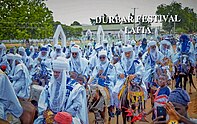Durbar festival




Durbar festival na old traditional yearly Hausa cultural, religious, and horse-riding festival. E be big part of di Arewa (Northern Nigerian) Hausa culture. Durbar don dey exist for centuries and na important part of Hausa kingdom and tradition. E dey show di cultural rites, tradition, and history of di Hausa people, wey dem sabi well as ancient horsemen and warriors of di Sahara and Sahel.
Dem dey perform Durbar for many northern cities of Nigeria, including di old Hausa Emirates like Kano, Katsina, Lafia, Gombe, Akko Emirate, Sokoto, Zazzau, Bauchi, Bida, and Ilorin. Dis festival dey usually happen after Ramadan and e dey join with di Muslim celebrations of Eid al-Adha and Eid al-Fitri.Kano Durbar Festival na di most spectacular horse parade for Northern Nigeria (Arewa), and e dey celebrate di cultural treasure of di Hausa Kingdom.
E dey start with prayers for early morning, then dem go do colourful horse parade of di Emir, im horsemen, musicians, and people wey dey handle artillery. For di Durbar festival, noblemen go travel come pay respect to di Emir and show loyalty to their emirates.
Di festival don start since di 14th century for Kano, di Hausa Kingdom Emirate, wey be di biggest city for Northern Nigeria. Kano Durbar Festival na four-day event full of style, horse-riding, and street parades.
Di word "Durbar" come from Persian origin, and dem first use am for ceremonial gatherings to mark Queen Victoria as di Empress of colonial India for 1877. But di Hausa people dey call di festival "Hawan Sallah," wey mean "Mount of Eid," because of di way dem dey mount horse for di celebration.
How ee take happen
[chenj-am | chenj-am for orijin]Befor Oyinbo start to dey rule naija
[chenj-am | chenj-am for orijin]Historians talk say "Hawan Daushe" (Mount of Daushe) start for Kano during di reign of Muhammadu Rumfa for di 1400s. During and after di Fulani Jihad, horses dey very important for war to protect di Emirate. Each noble family get responsibility to defend di Emirate by forming their own regiment.Once every year, dem go gather di regiments for military parade to show di Emir their horsemanship, war readiness, and loyalty.
Di main show for di Durbar na di Jahi race, wey be di last event for di Hawan Daushe program. Plenty horse riders for di emirate go charge full speed towards di Emir, then stop suddenly near am, wave their sword or flag, and then commot. Di Emir and im people go ride pass different areas wey get historical meaning, before dem go return palace through di Kofar Kudu gate for di Jahi, wey be salute from di horsemen. After di Jahi, palace guards go march, shoot gun for air, and announce say di Hawan Daushe Durbar don finish.
Di festival dey start with Hawan Sallah (di riding for di festival), followed by Hawan Daushe, Hawan Nassarawa, and Hawan Doriya. Di most exciting and amazing part of di Durbar celebration na di Hawan Daushe, wey include di Jahi, and e dey attract people from all over di world.
Hawan Daushe dey start as di Emir and im people ride out from Gidan Rumfa – di Emir Palace. Dem go pass Kofar Kwaru reach Babban Daki, wey be di palace of di Queen Mother, to pay respect to im mama.
Time wey Oyinbo dey rule naija
[chenj-am | chenj-am for orijin]Di Durbar festival show well-well for di 2nd World Black and African Festival of Arts and Culture, wey dem dey call Festac 77. After Festac, di colonial origin begin fade small-small, and dem link di events to pre-colonial traditions like how horses dey important for military things and ceremonies for di Bornu Empire, plus di ceremonies of "Hawan Sallah" and "Hawan Idi".
For December 2024, UNESCO recognize di festival as Intangible Cultural Heritage
Make you chek
[chenj-am | chenj-am for orijin]- Festivals fo Nigeria
Where we see am from
[chenj-am | chenj-am for orijin].mw-parser-output .reflist{margin-bottom:0.5em;list-style-type:decimal}@media screen{.mw-parser-output .reflist{font-size:90%}}.mw-parser-output .reflist .references{font-size:100%;margin-bottom:0;list-style-type:inherit}.mw-parser-output .reflist-columns-2{column-width:30em}.mw-parser-output .reflist-columns-3{column-width:25em}.mw-parser-output .reflist-columns{margin-top:0.3em}.mw-parser-output .reflist-columns ol{margin-top:0}.mw-parser-output .reflist-columns li{page-break-inside:avoid;break-inside:avoid-column}.mw-parser-output .reflist-upper-alpha{list-style-type:upper-alpha}.mw-parser-output .reflist-upper-roman{list-style-type:upper-roman}.mw-parser-output .reflist-lower-alpha{list-style-type:lower-alpha}.mw-parser-output .reflist-lower-greek{list-style-type:lower-greek}.mw-parser-output .reflist-lower-roman{list-style-type:lower-roman}Templet:Authority control
